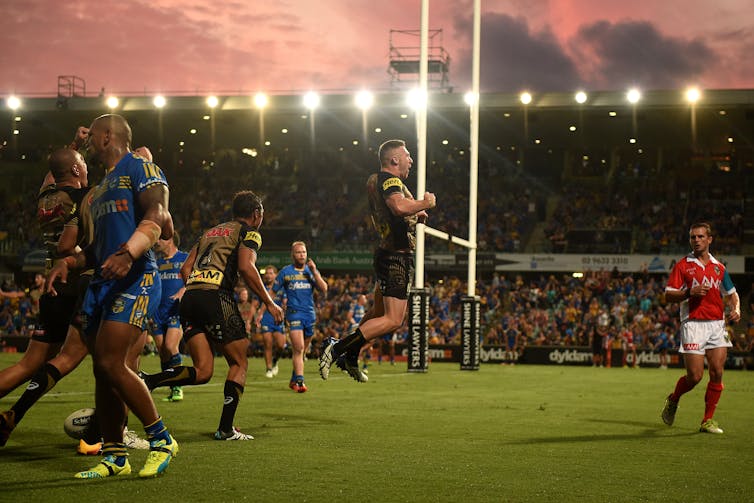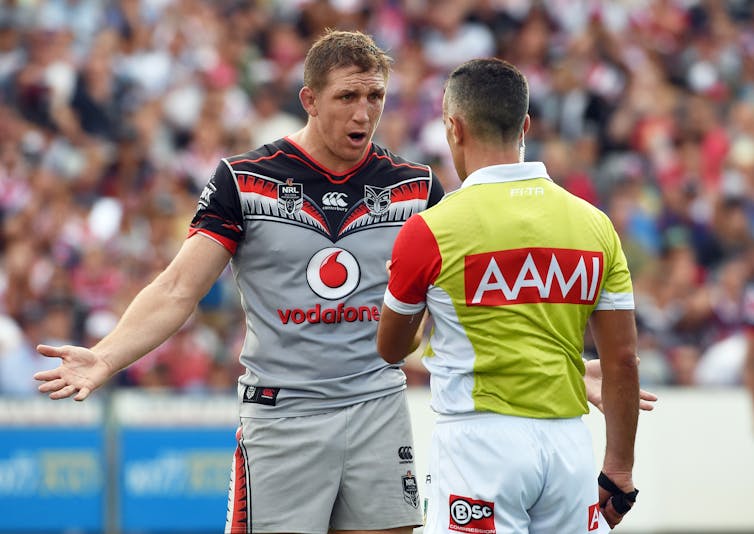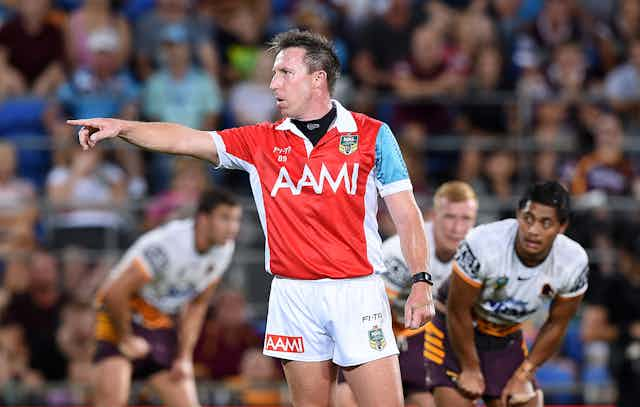Whomever you support in any National Rugby League (NRL) footy game, it’s important to remember there’s always a third team in play that seldom gets much support: the refereeing crew.
For every knock-on, restart and try scored, this six-person unit deftly coordinates thousands of decisive calls and split-second decisions at match speed.
And all this is done while under intense player and public scrutiny.
NRL referees consistently manage around 282 rucks per game and 36 kicks in play. They adjudicate on approximately 20 player errors, 38 restarts and 14 penalties while covering a total distance of around eight kilometres per game.
Match officials spend a staggering 31% of game time in high anaerobic heart rate sectors of 170 beats per minute (bpm) or above.
How, then, under such demanding physical and mental circumstances, do these high-performance arbitrators effectively administer and communicate their decision-making outcomes?
Close calls
After spending eight busy days this month immersed in the business of NRL refereeing, I was extremely impressed with the professionalism and work rate of all involved.
It highlighted to me the lack of public knowledge about how these elite athletes operate. There is an enormous volume of communication taking place during each game, and technology’s had a huge impact on the role and responsibilities of the modern-day official.
The lead and assist referees facilitate match-day decisions in partnership with their two touch judges. Further support is provided each week by both the match-day referee coach and a senior review official located in the video ref’s bunker.

I attended the Eels v Panthers game at Parramatta Stadium in western Sydney. The referees’ coaching box was a small space in which the match-day official was required to effectively operate. It was already half-packed with equipment.
Noise and movement from broadcast boxes either side continually intruded while technical staff repeatedly entered and left as the game progressed.
And yet, the match-day referee’s focus in this small area was unwavering. Concentration was maintained as he astutely watched every play of the game and confirmed decisions and ruck counts.
By judiciously communicating with the other referees and touch judges on field, the match-day referee provided immediate clarity and confidence at key times throughout the match for both the lead and assist referee.
During the course of a typical game, lead referees have to cope with listening to their assist referee, two line judges, the match-day referee coach, players and occasionally spectators who attempt to provide their own “helpful” advice.
Hundreds of communications are taking place each minute. Few of us hold jobs where at least five people are simultaneously speaking at us and where split-second responses are required. Key decisions may also change the mood of a large group of people in their immediate vicinity from friendly to hostile in a short space of time.
The video ref bunker
This season has seen the set up of a centralised video referee, based in a bunker at the Australian Technology Park in Eveleigh, Sydney, where a team of officials are required to watch over all NRL games.
In contrast to the on-field refereeing, scenes inside the video referee bunker were far more comfortable. With no interruptions and plenty of soundproofed space, match review officials clinically oversaw decisions being made at a distance.
Devoid of match-day emotions and distractions but just as busy as the match-day coaching box with little changeover time between games, an impressive array of touchscreen interfaces, zoom functions and enhanced camera angles were continually accessed in order to provide alternative sources of match-day information to the on-field referee team when required.
At the same time, in another section of the bunker, referee coaching staff were constantly editing key sections of decision-making plays in order to produce coaching segments designed to provide feedback and improve referee performance prior to the next round of games.
Who goes home from their day job to analyse their own performance for the next three hours? Which families get to continually hear about their job security in the media? And who gets their work statistically micro-analysed by a personal coach every week?
When the refs get it right
NRL refereeing must be one of the most high pressure and publicly scrutinised jobs on the Australian sporting landscape. And yet, data reveals that NRL referees had an 81.4% decision-making success rate for their round five games this season. It was an astounding 94% success rate for the Eels v Panthers game I attended.
Why then do we focus so strongly on referee mistakes rather than player mistakes?

Realistically, they can only officiate the match that comes before them. If players are intent on committing penalties, then referees have no choice but to blow the whistle on them.
And yet, the performances of referees appear to be shaped quickly by strong opinions in the aftermath of games by players, coaches and media alike. This includes the new video referee bunker decisions that have also been subject to some criticism this season.
If people only see the condensed footage currently being broadcast, then it must be difficult to accurately assess and comment on referee mistakes at all.
In future, solutions might be to display the multiple camera angles available to bunker officials instead of the basic vision currently being shown. By combining broadcast vision with real-time lead and assist referee communications, angst currently being directed at referees might be further reduced.
Broncos coach Wayne Bennett believes the bunker system has already shown its worth when he said at the weekend:
The bunker has many plusses to it, but is it the perfect system? No it’s not, because there is human error there.
That’s the bottom line. I don’t know why we keep beating ourselves up about it, because it is better than what we had.
That’s something to consider next time you’re about to criticise the referee in any NRL game.

